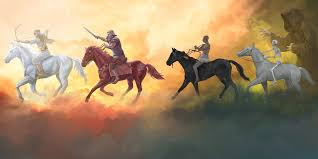The four horsemen are as follows:
The first horseman rides a white horse and carries a bow and crown. In the bible, it says that the rider "...went forth conquering; and to conquer".
The second horseman rides a red horse and carries a "great sword". The riders' power was to "Take peace from the Earth".
The third horseman rides a black horse and carries a pair of balances. He is essentially famine.
The fourth horsemen ride a pale horse and the riders name is Death. The bible says that Hell followed with him.
Together their power, as stated in the bible, is "...to kill with sword, and with hunger, and with death, and with the beasts of the earth."





